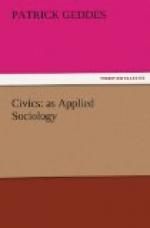For just as we have seen on the old coin the hammerman [Page: 100] and his motto answer to the town and school; so now on its reissue to the renascent local arts and crafts, with their commemoration in this library. And as the greater motto, that of widest policy, corresponds to the cloister of reflection and resolve, so we note that this new impulse to civic betterment is associated with the new library—no mere school-house of memory, but also the open cloister of our day. Finally, note that this impulse is no longer merely one of aesthetic purpose, of “art for art’s sake,” nor its execution that of a cultured minority merely; it announces a re-union of this culture and art with the civic polity. What fitter occasion, then, for the striking of a medal, than this renewal of civic life, with municipal organisation and polity, art and culture, renascent in unison. That such events are nowadays far from exceptional is so true that we are in danger of losing sight of their significance. Yet it is amid such city developments that the future Pericles must arise.
We thus see that our analysis is no mere structural one, made post-mortem from civic history; but that it applies to the modern functioning of everyday life in an everyday city, so soon as this becomes touched anew towards cultural issues. Furthermore, it is thus plain that civic life not only has long ago anticipated and embodied our theories of it, but once more outruns them, expressing them far better than in words—in life and practice. In this way the reader who may most resent these unfamiliar methods of exposition, alternately by abstract diagram or concrete illustration—which may seem to him too remote from ordinary life and experience, perhaps too trivial—may now test the present theory of the city, or amend it, by means of the ample illustrations of the processes and results of social life which are provided by his daily newspaper, and these on well-nigh all its fields and levels.
Note finally that it is the eagle and lamb of temporal and spiritual idealism that form the “head” of this coin, the craftsman and anvil but the modest “tail.” The application is obvious.




